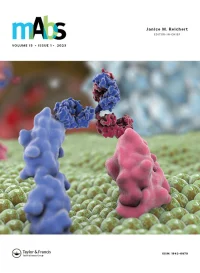
Publication I December 1, 2022
Kinetic analysis of ternary and binary binding modes of the bispecific antibody emicizumab
The binding properties of bispecific antibodies (bsAb) are crucial for their function, especially when two antigens are targeted on the same cell surface. Dynamic interactions between each of the antibody’s arms and its cognate target cause the formation and decay of a biologically functional ternary complex. How association and dissociation processes work cooperatively, and how they influence the avidity of the ternary complex, is still poorly understood. Here, we present a biosensor assay for the simultaneous measurement of the binding kinetics of the therapeutic bsAb emicizumab (Hemlibra®) and its two targets, the blood coagulation factors IX and X (FIX, FX). We describe an automated workflow to characterize binary and ternary-binding modes, utilizing a Y-shaped DNA nanostructure to immobilize the antigens on a sensor and to emulate conditions on a cell or platelet surface by presenting the antigens with optimal accessibility for the bsAb flown over the sensor as analyte. We find that emicizumab binds FX much stronger than FIX (Kd = 0.05 µM vs. 5 µM, t1/2 = 20 s vs. 1 s) with profound consequences on the avidity of the ternary complex, which is dominated by FX’s binding properties and a hand-off mechanism from FX to FIX. Moreover, formation and decay of the ternary complex depend on the bsAb concentration during the association phase. Emicizumab’s in-vivo mode of action and the catalytic activation of FX can be rationalized from the analyzed binding kinetics. The assay and workflow are well suited for the screening of bispecific binders in drug discovery and provide valuable new kinetic information.